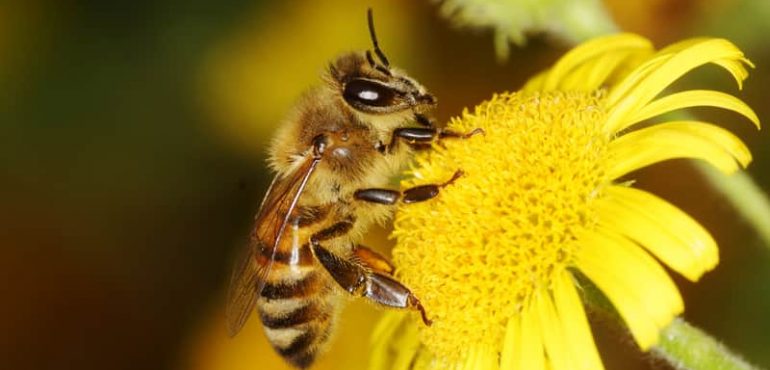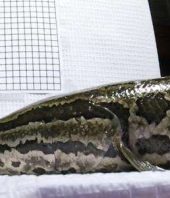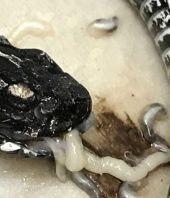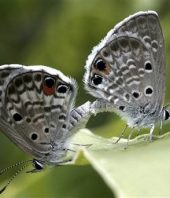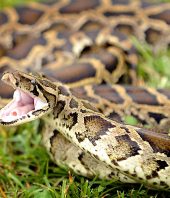The tale of the honeybee is a sadly familiar one: a once-thriving species is on the ropes. After brutal bouts with mites and fungi, honeybees are now facing their most dangerous threat yet: a mysterious disease called colony collapse disorder. In the winter of 2010 alone, U.S. beekeepers reported losing 34 percent of their hives to CCD, which may be caused by viruses, pesticides, or some diabolical combination of factors. Researchers are working hard to figure out exactly why the honeybees are dying and how to save them because of their ecological importance. Honeybees pollinate many of the country’s fruit and vegetable crops, and they also carry out the same service for many species of wild plants. In Brazil, honeybees help keep isolated rain forest fragments from dying out by moving their pollen from tree to tree.
Amidst all the concern for the honeybees, it’s easy to forget an important fact about them. They’re not native to the New World.
The earliest records of honeybees in this hemisphere come from English settlers who arrived with hives aboard their ships in the early 1600s. They brought the bees to make honey they could eat and wax they could burn. Over the past four centuries, new stocks of honeybees have arrived at least eight times, from Europe, the Near East, and Africa.
Introduced species can, in some cases, become dangerous invaders, wreaking havoc on their new homes. They may gobble up native species, outcompete them, or just infect them to cause new diseases. Much of modern conservation management is organized around keeping alien species out and killing off the ones that made it in. And yet there are no loud voices calling for the alien honeybees to be wiped out in the New World.
“It’s almost like everyone politely ignores that they’re not native,” says Dov Sax, a conservation biologist at Brown University.
Sax and some of his fellow biologists think that it’s time to give some serious consideration to this paradox. In a paper published in Conservation Biology, Sax and two colleagues argue for recognizing the ecological value of some introduced species. “We predict the proportion of non-native species that are viewed as benign or even desirable will slowly increase over time,” they write.
The fact that a journal like Conservation Biology would publish such a statement is a testament to how seriously some researchers are taking the idea. “It’s considered edgy, but it’s not considered nuts,” says Sax. Not nuts, perhaps — but certainly not innocuous. The new paper is eliciting strong responses from other conservation biologists — ranging from hearty endorsements to fierce protests.
Introduced species can, in some cases, become dangerous invaders, wreaking havoc on their new homes. They may gobble up native species, outcompete them, or just infect them to cause new diseases. Much of modern conservation management is organized around keeping alien species out and killing off the ones that made it in. And yet there are no loud voices calling for the alien honeybees to be wiped out in the New World.
“It’s almost like everyone politely ignores that they’re not native,” says Dov Sax, a conservation biologist at Brown University.
Sax and some of his fellow biologists think that it’s time to give some serious consideration to this paradox. In a paper published in Conservation Biology, Sax and two colleagues argue for recognizing the ecological value of some introduced species. “We predict the proportion of non-native species that are viewed as benign or even desirable will slowly increase over time,” they write.
The fact that a journal like Conservation Biology would publish such a statement is a testament to how seriously some researchers are taking the idea. “It’s considered edgy, but it’s not considered nuts,” says Sax. Not nuts, perhaps — but certainly not innocuous. The new paper is eliciting strong responses from other conservation biologists — ranging from hearty endorsements to fierce protests.
Schlaepfer and his colleagues stress that they’re not calling for every introduced species to be protected, or even tolerated. Instead, they hope the conservation community will at least consider the possibility that introduced species can do some good. “It’s going to cause one more round of reflection,” says Schlaepfer.
The new paper has attracted strong criticism, some directed at its big message and some at the evidence the authors marshall to build it. Thomas Gavin, a Cornell conservation biologist, sharply disagrees with the way Schlaepfer and his colleagues envision the way ecosystems work — particularly with the idea of analyzing introductions of species “as if the system were simply a collection of interchangeable parts, like some human-devised machine. I reject this notion.”
Other conservation biologists take issue with the examples that Schlaepfer and his colleagues select. To suggest that the Japanese white eye has a positive role because it pollinates a native vine is “totally ludicrous,” says David Richardson of the University of Cape Town in South Africa. “This bird is the main disperser of many non-native plants into native ecosystems,” he points out. “The net outcome of this species just has to be negative.”
Yet Richardson agrees that it’s time to think differently about invasive species. He thinks conservation biologists have to set aside purist ideas about restoring ecosystems to some pre-human state. In cases where habitats have been radically altered, he says, “removing alien species just because they are alien is futile.”
A particular passionate endorsement comes from Scott Carroll, a conservation biologist at the University of California, Davis. “My admittedly ludicrous response to the paper is ‘Yes! Go! May your sensible perspective sprout wings!’” he says.
Carroll makes a similar argument in the latest issue of the journal Evolutionary Applications, where he calls for a new kind of science he calls “conciliation biology.” Simply trying to eradicate all exotic species can be costly, he argues, and can even harm native species. Introduced cats were eradicated from Maquarie Island off the coast of Australia, after having driven two of the island’s bird species extinct. But with the cats gone, an introduced population of rabbits exploded, devouring the native plants.
The failure on Maquarie Island, Carroll argues, stems from a failure to appreciate that species are constantly evolving. In the mid-1900s, scientists introduced a virus into Australia and its surrounding islands to control rabbits. Conservation biologists assumed that they could get rid of cats and the virus would still keep the rabbits at low levels. But the virus, meanwhile, had evolved to become less deadly, which enabled it to spread more efficiently but made it ineffective in controlling the rabbits.
Rather than try to restore ecosystems to their pre-industrial states, Carroll argues, conservation biologists should manage the evolution of species to make ecosystems resilient. If a vine starts to spread across a new habitat, for example, conservation biologists can help native insects to evolve mouthparts that allow them to devour the vines more quickly. Rather than signaling defeat, Carroll sees conciliation biology as a way to reach more sustainable outcomes in a human-dominated world.
Source: Yale University, Full Article

